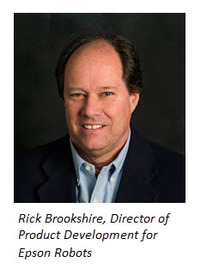|
The robotics technology required for automation, once prohibitively expensive and inaccessible to most, has become more affordable and easier to use in recent years. Many companies now use robotics to improve productivity throughout their automation processes—and many more will likely do so in the near future. We sat down with Rick Brookshire, Director of Product Development for Epson Robots, to get his perspective on current trends and long-term possibilities in a rapidly changing industry. |
 |
What do you see as current trends in the robotics industry?
Rick: There have been a lot of technological improvements to both the ease-of-use and performance of robots in recent years. At Epson, we offer integrated vision and force guidance, enabling robots to perform more applications that were previously considered not feasible, while also reducing total development time. This allows manufacturers to perform high precision applications that were previously impossible.
Another example is Epson’s new IntelliFlex Feeding System. In order to feed parts, customers previously had to purchase the robot, vision system, and flexible feeder separately. Development time for making all the components work together can take weeks. If something goes wrong, a manufacturer needs to call each component’s support department individually.
The IntelliFlex Feeding System includes the robot, vision system, flexible feeder, and software. All components work together in the same development environment, Epson RC+. That drastically reduces the development and set up time compared to alternatives in the market.
What about collaborative robots? Will this trend continue in the future?
Rick: An issue since COBOTS (Collaborative Robots) were first introduced to the industry is that many people believe that since they are using a COBOT (Collaborative Robot) that their application is safe. But it’s the application that can be collaborative (robot and person working in the same area) and not just the robot. The new ISO10218-Safety standard addresses this issue and basically says that there is no longer a Collaborative Robot type but only Collaborative applications. So, the line between Industrial robots and the so-called COBOTS has now become much closer. There are now Industrial Collaborative applications where Industrial robots are being used that meet the latest safety monitoring standards with redundant safety boards (inside robot controllers) that monitor industrial robots with external safety equipment like laser sensors, light curtains, floor mats and much more to cause robots to slow down and/or stop depending upon the safety requirements of the application.
These Industrial Collaborative applications are built using Industrial robots to get the best of both worlds — speed from the industrial robots and safety systems which do not require enclosed structures. The important difference today versus a few years back is that much of this safety monitoring was done by SW and had opportunities for faults. Now this is done through HW systems with redundancy bringing much more reliable safety systems to Industrial Robots. At Epson, we call this technology SafeSense.
What role does AI play in automation today and in the future?
Rick: It is easy for customers and vendors to jump in headfirst with AI and try to use AI for everything. It’s important to take baby steps, and then walk before we run. We need to have the robots adjust and learn based on using the AI. We are now applying simple AI to Epson products, such as our flexible feeder product, IntelliFlex Feeding System.
Another area where AI is really starting to take off is with Vision system where systems are learning the characteristics of good and bad parts, and improving the knowledge of the characteristics of good parts over time to help improve the finding and inspection of parts and features.
What are your predictions for the future of automation?
Rick: What do they say: “better, faster, cheaper?” There’s a lot of truth to this statement when it comes to automation. We are continuously making robots faster and easier to use with fully integrated solutions.
I compare robots and automation to the telephone. Today, a five-year-old can call Grandma without any help. She simply says, “Call Grandma.” Thirty years ago, a five-year-old couldn’t do it. They didn’t know the number and couldn’t dial the numbers correctly. But now, the telephone is super easy for people to use.
Robots need to move in the same direction as the phone and there are some technologies allowing us to get there faster, including AI, as you asked about in the previous question.
What do you think needs to happen on the development side to make robots easier to use?
Rick: We need to get to the point where robot programs are no longer required. Manufacturers need to be able to configure the application for their processes. We’re headed in that direction, but we still have a long way to go, as an industry.
What features are robot vendors adding that make it easier to program?
Rick: To make programming easier, it should be simplified to the point that customers can just go through a wizard to set up the robot instead of writing custom code. Our IntelliFlex Flexible Feeder software generates code templates. Customers simply fill in the templates to customize the application.
What are your thoughts on where automation is headed in the future?
Rick: Speed is still a top priority for customers. They want faster throughput in their factories so they can build more parts or products per minute, which increases revenue. While we have made tremendous strides in terms of speed, we are constantly working to build faster robots.
Learn more about using automation and what components you need to improve productivity and increase revenue.